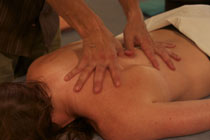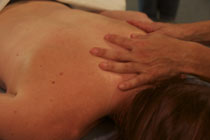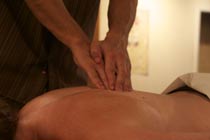Neuromuscular Therapy (NMT)
The History of Neuromuscular Therapy (Trigger-point Therapy)
 The origins of Neuromuscular Therapy can be traced in Europe and are credited to a natural healer named Stanley Lief, who was born in Latvia in the 1890s (Benjamin& Tappan, 2004). He established a world-renown natural healing resort in 1925 in Champneys in Hertfordshire, England. There he developed soft tissue manipulative methods that are very similar to the neuromuscular therapy practiced by therapists in the United States today (Benjamin& Tappan, 2004). NMT was part of a holistic approach to healing, which incorporates diet, emotional health, and hydrotherapy, as well as soft tissue manipulation (Chaitow, 1996).
The origins of Neuromuscular Therapy can be traced in Europe and are credited to a natural healer named Stanley Lief, who was born in Latvia in the 1890s (Benjamin& Tappan, 2004). He established a world-renown natural healing resort in 1925 in Champneys in Hertfordshire, England. There he developed soft tissue manipulative methods that are very similar to the neuromuscular therapy practiced by therapists in the United States today (Benjamin& Tappan, 2004). NMT was part of a holistic approach to healing, which incorporates diet, emotional health, and hydrotherapy, as well as soft tissue manipulation (Chaitow, 1996).
Janet Travell, medical pioneer of trigger point therapy, published her first work on this subject in 1952. She was credited with relieving the debilitating pain of the young Senator John F. Kennedy, who was injured in World War II. She was then appointed as White House physician to both Presidents Kennedy and Johnson in the 1960s, which brought her work to the attention of the public (Claire, 1995, p. 42). Travell later co-authored with David Simons to write the definitive work on trigger point therapy in two volumes. (Benjamin& Tappan, 2004)
Bonnie Prudden developed a systematic approach to addressing trigger points, which became popular in the 1970-1980s. Prudden's two books, Pain Erasure and Myotherap, provided pratical descriptions of how to locate and relieve common trigger points in different parts of the body. Prudden contributed her efforts to make NMT accessible within the developing field of massage therapy, and to the general public. (Benjamin& Tappan, 2004)
What Is Neuromuscular Therapy?
 Before getting to the definition of Neuromuscular Therapy, we should first define the term: trigger point (TrP). TrP is defined as "a focus of hyperirritability in a tissue that, when compressed, is locally tender and, if sufficiently hypersensitive, gives rise to referred pain and tenderness, and sometimes to referred autonomic phenomena and distortion of proprioception" (Travell & Simons, 1999, p. 4). Simply put, TrP is a hyperirritable spot that can trigger a painful response in other areas of the muscle (Ryan). Trigger points may develop as a result of trauma, poor posture, repetitive strain, or overwork of muscles (Benjamin& Tappan, 2004).
Before getting to the definition of Neuromuscular Therapy, we should first define the term: trigger point (TrP). TrP is defined as "a focus of hyperirritability in a tissue that, when compressed, is locally tender and, if sufficiently hypersensitive, gives rise to referred pain and tenderness, and sometimes to referred autonomic phenomena and distortion of proprioception" (Travell & Simons, 1999, p. 4). Simply put, TrP is a hyperirritable spot that can trigger a painful response in other areas of the muscle (Ryan). Trigger points may develop as a result of trauma, poor posture, repetitive strain, or overwork of muscles (Benjamin& Tappan, 2004).
Neuromuscular Therapy is performed to deactivate trigger points (TrP) in muscle and related connective tissues (Benjamin& Tappan, 2004). NMT techniques deactivate TrPs that cause pain, weakness, and limited flexibility (Benjamin& Tappan, 2004). Jim Thomason also defines NMT as a way aiming to "balance the central nervous system with the musculoskeletal system to correct any disorders brought about as a result of any imbalances between the two".
Cate Miller (LMT) has surpassed her 30th year as both a teacher and therapist in the massage profession. She is so passionate about Integrative Neuromuscular Therapy and facilitating the healing process. She is currently teaching Neuromuscular Therapy at Florida School of Massage. In the following video she gives us a brief introduction of Nueromuscular Therapy:
Health Benefits
 Neuromuscular Therapy is an effective and well-recognized means of providing relief from soft tissue pain problems (Integrative Therapeutic Massage). NMT can improve many health-related conditions and movement-related injuries such as lower back pain, sciatica, neck & shoulder pain, Tendonitis and Carpal tunnel Syndrome (Integrative Therapeutic Massage). The American Academy of Pain Management recognizes NMT as an efficient way to treat back pain caused by soft tissue injury (such as a muscle strain) (Mueller). NMT is also used to adress Ischemia, postural distortion, nerve compression or entrapment and biomechanical dysfunction (e.g., poor lifting habits) (Fenity).
Neuromuscular Therapy is an effective and well-recognized means of providing relief from soft tissue pain problems (Integrative Therapeutic Massage). NMT can improve many health-related conditions and movement-related injuries such as lower back pain, sciatica, neck & shoulder pain, Tendonitis and Carpal tunnel Syndrome (Integrative Therapeutic Massage). The American Academy of Pain Management recognizes NMT as an efficient way to treat back pain caused by soft tissue injury (such as a muscle strain) (Mueller). NMT is also used to adress Ischemia, postural distortion, nerve compression or entrapment and biomechanical dysfunction (e.g., poor lifting habits) (Fenity).
